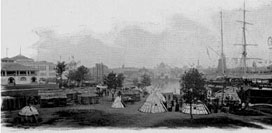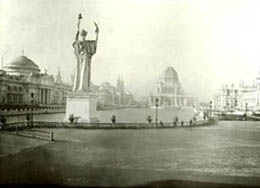|

American Indians at Chicago's Columbian Exposition |
The Exposition occurred at a key moment in the nation’s history: It was planned as part of a celebration of four hundred years of “progress” since Columbus’s arrival in the “New World” and was designed to showcase advances in technology, science, government, the arts, and human relations since 1492. But, in early 1893, a financial panic threw the United States into an industrial depression more serious than any the country had ever before experienced. Banks closed, jobs disappeared, suffering increased, and doubts about the inevitable march of “progress” swept the country. Yet the Fair went on.
The official goals of the Exposition were overtly nationalistic: Its promoters hoped to provide stability in the face of great change, to encourage American unity, to celebrate technology and commerce (“progress”), and to encourage popular education. These themes were echoed in later World’s Fairs held in Chicago and New York in the 1930s, and continue today in those most permanent of American fairs, Disneyland and DisneyWorld. In some ways, though, the Columbian Exposition dwarfed them all.
Another
good article on this subject is Ray Fogelson’s “The
Red Man in the White City”, published in Native Chicago (2002).
|
| |
Department
of Anthropology |
copyright © 2002
University of Illinois, All rights reserved. |



